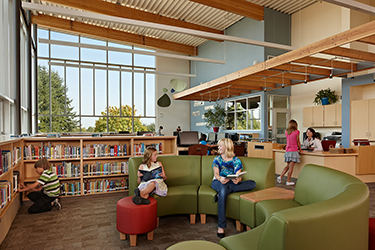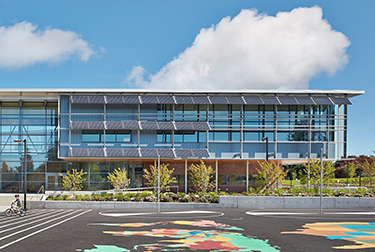|
Subscribe / Renew |
|
|
Contact Us |
|
| ► Subscribe to our Free Weekly Newsletter | |
| home | Welcome, sign in or click here to subscribe. | login |
Architecture & Engineering
| |
 |
October 30, 2014
Energy-efficient design goes to school
NAC Architecture

Riedel
|
The energy efficiency of new buildings has garnered increasing attention over the last several years. This focus has been particularly strong on public building projects, including schools in our area.
The result is a recent body of K-12 school buildings in Western Washington with impressive energy performance, which do not sacrifice important indoor environmental factors such as ventilation and daylight. Let’s examine what local design professionals have learned and successfully applied.
For a benchmark, I will use a metric called “site energy use intensity,” or site EUI. This is the annual energy used on site, divided by the gross building area. As reported by the EPA last month, the median site EUI for K-12 schools nationally is 58.2. Locally, Hargis Engineers’ Energy Services Group has compiled 2011-12 energy use data for 345 existing K-12 schools across 15 school districts throughout the Puget Sound area and found the following median EUIs:
• 45.8 for elementary schools
• 54.5 for middle schools
• 56.8 for high schools
Recently constructed schools in our region are achieving much better energy efficiency than these benchmarks. Some school buildings designed by our firm for the Bellingham, Snohomish and Bellevue school districts are operating with documented site EUI numbers in the 20s and below.
One outstanding example is the 83,400-gross-square-foot Cherry Crest Elementary School in Bellevue, which has operated for the past 12 months with an EUI of 17.2. When we count the reduction from energy provided by the solar panels, the net energy use was an actual EUI of 13.9.
What goes into the design to achieve this level of energy efficiency? Schools with EUIs in the 20s or lower will need to exceed minimum requirements of the Washington State Energy Code and the Washington Sustainable Schools Protocol. This article will outline several strategies and identify the best practices for each.
Integrated design
To achieve high performance without blowing the budget, a project needs clear energy efficiency goals from the start. Clear goals will enable the architect and engineers to make key early decisions that become embedded in the project design.
An early integrated design workshop sets goals at the start of the design process, and then recurring meetings and open communication among the design team are needed to accommodate performance features without costly changes. Cost modeling helps evaluate combinations of strategies to facilitate decision-making.
Insulation
In the past few years, the air-tightness and insulation of the building envelope has become a critical focus. Exterior wall assemblies are now required to have continuous insulation and air barriers, eliminating thermal bridges that conduct heat from inside to outside.
Today’s “super-insulated” walls have true insulation values between R-25 and R-30; roofs often have R-45. These values are a significant improvement over common building practices 10 years ago. The best practice at framed walls is to include spray-foam insulation between the studs and continuous insulation outside the wall cavity. Spray foam provides both a high insulation value and a good seal to prevent air infiltration.
Window and curtain wall improvements have addressed the most significant areas of heat transfer through the envelope. We have used triple-pane glazing in some recent schools to improve thermal performance while providing ample daylight to classrooms. Triple-glazed gasketed curtainwall systems can exceed R-5 insulation value while maintaining clear views.
Heating
The climate of Western Washington makes heating far more important than cooling in our buildings. The choice of a heating system is one of the most critical pieces of the energy efficiency puzzle. There are a variety of factors to consider in choosing a heating system, but all of our best-performing schools use ground-source heat exchange. This system takes advantage of the difference in temperature between the air and underground to feed very efficient heat pumps.
Another best practice is heat recovery, which transfers heat from air being exhausted out of the building to fresh air being brought into the building. There are a number of available heat recovery system types, but the best performing are reverse-flow heat recovery systems, which can achieve 90 percent effectiveness. Reverse-flow units are larger and heavier than other heat recovery types, so the choice of system needs to be made per project.
Ventilation
The most significant factor requiring energy use for heat is the amount of fresh air used for ventilation. Codes have increased the required ventilation in recent decades. Also, adequate ventilation is needed for school buildings, because fresh air benefits attention and learning. While heat recovery can mitigate much of the heating impact of good ventilation, there are other system choices to be made.
I was part of the NAC/Hargis team which pioneered the use of displacement ventilation for school buildings in Washington 10 years ago, and I still consider it to be best practice.
The principle behind displacement ventilation is to introduce air low in the room and let it stratify and move by natural convective forces upward to be exhausted at the ceiling. Because the air is not being forced by overhead diffusers to mix in the room, the maximum benefit is gained from the ventilation air, resulting in a significant improvement in indoor air quality. Combined with the inherent quietness of a displacement ventilation system, it has a lot of advantages for classroom applications.
Daylight harvesting
Good use of natural daylight is an important part of a well-designed educational environment. The basic principles of good daylighting include bringing ample daylight in from multiple sides of a room while avoiding harsh direct sunlight, reducing contrast and glare by using reflective surfaces to balance daylight across a room, and providing user control over daylight sources.
Computer modeling known as ray tracing is very helpful in predicting successful daylighting during design.
In a well-designed classroom, significant energy savings can be achieved with automatic-dimming electric light fixtures controlled by photocells, a strategy known as daylight harvesting. This reduces the amount of energy used when there is enough natural light in a classroom. New LED light fixtures make this easier to achieve than with previous dimming fluorescent fixtures.
Solar power
Generating electricity with solar panels should not be a substitute for the design strategies described above, but it is a valid final step in reducing utility-provided power after these conservation steps have been taken. Solar thermal panels (for hot water) do not often work as well with school water use patterns as they do in residential applications, but photovoltaic panels are effective.
Even in cloudy Western Washington, photovoltaic arrays can generate a significant portion of the power needed to run a school. Several of our best-performing schools have 100-kilowatt arrays, which help in lowering their EUI.
Energy dashboard
A great way to inspire school staff and students to reduce energy use at their school is to give them real-time feedback. This can be done with an “energy dashboard,” typically an interactive touchscreen near the school entry. When building users can see how much energy is being used, they can become part of the energy reduction solution.
This has been just a short survey of strategies to design new schools for energy efficiency; there is much more information and many contributing factors to consider in each of these categories. These strategies will also work on other building types, but integrated design requires specific factors to be considered for each project.
Philip Riedel, AIA, CEFP, LEED BD+C, is associate principal at the Seattle office of NAC Architecture, chair of the firm’s Sustainability Community of Practice and former president of the Washington Chapter of the Council of Educational Facilities Planners International.
Other Stories:
- 5 tools needed to run successful meetings
- Survey: Magnusson Klemencic Associates
- Survey: PCS Structural Solutions
- Survey: Graphite Design Group
- Survey: Notkin Mechanical Engineers
- Survey: Walker Macy
- Survey: Callison
- Survey: CollinsWoerman
- Is Seattle’s housing market falling into the ‘San Francisco Death Spiral’?
- Lean design shines in tricky healthcare projects
- Commissioning is key to a smooth running central utility plant
- Electronic data loss can become a shocking surprise
- D/B competitions: a high-stakes poker game you can’t win
- Why tomorrow’s engineer needs a different education
- Survey: Driftmier Architects




